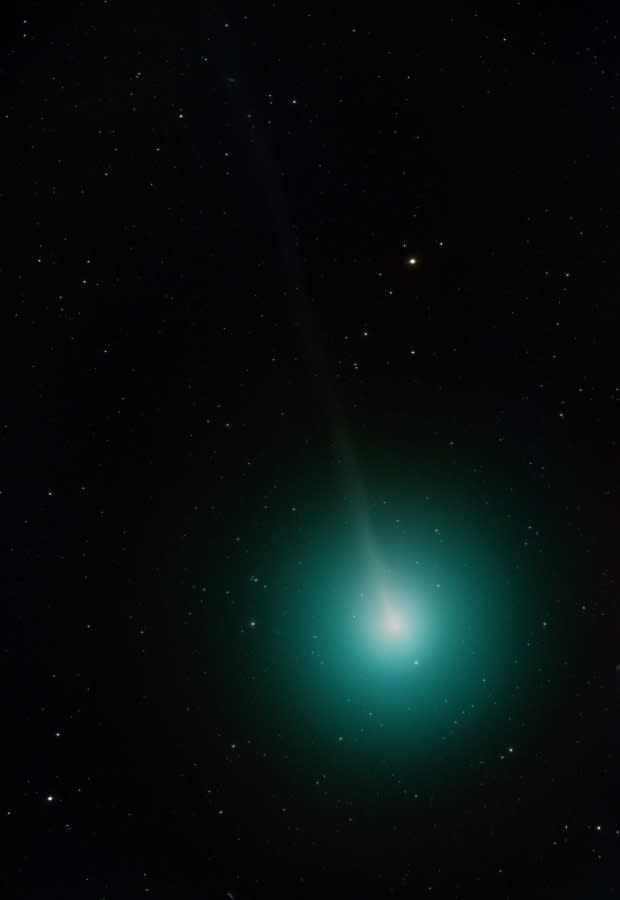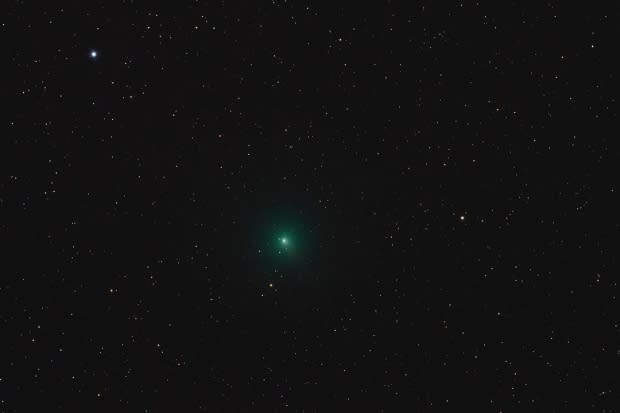Brightest comet of the year makes its closest approach to Earth on Sunday
If you have clear skies and are willing to brave the chilly temperatures, you might want to head to a dark site and look for a passing visitor on Sunday night.
Comet 46P/Wirtanen, first discovered in 1948, will be making its closest approach to Earth in its orbit around the sun.
Though the comet has been visible from dark sites for about a week, it's expected to be at its brightest on Sunday.
While this is the brightest comet of the year and the 10th closest comet in modern times, it's not producing a well-defined tail, a hallmark of comets.
Instead, Wirtanen — a small comet at just 1.2 kilometres in diameter — is a fuzzy, bluish object in the southern sky.

Comets, often referred to as "dirty snowballs," are leftover collections of dust, gas and ice from the formation of our solar system. Most are from two regions — the Kuiper Belt and the Oort Cloud — at the outer edge of our solar system. Once in a while they get knocked out of these regions and begin a voyage around the sun.
As a comet approaches the sun, its ice sublimates (changes directly from a solid to a gas, skipping the liquid phase), which produces its characteristic tail. A comet's brightness depends on its size and how much ice and gas it contains.
People are already snapping photos of the comet from around the world.
This 3.1-hour time-lapse clip shows Comet 46P/Wirtanen moving across the sky. (Courtesy Alex Cherney (http://terrastro.com/)
Where to look
The brightness of celestial objects is on a scale that goes from the very brightest — the sun — to the dimmest. And it doesn't go in the direction you'd think: the lower the number (negative values) the brighter the object.

At the moment, 46P/Wirtanen is near magnitude 4, so not quite visible to the naked eye in light-polluted skies. It's estimated that when Wirtanen is at its closest position to Earth, on Dec. 16, it could reach a magnitude of 3.
So, if you're heading out to catch a glimpse of the comet, make sure you try to get to as dark a location as possible. And don't look at your phone. Allow your eyes to adjust to the darkness, which in turn allows you to see dimmer objects.
If you have a pair of binoculars, use them.
Look to the southern sky, where you'll find the very recognizable constellation Orion, known as the hunter. On Dec. 8, Wirtanen will be about 32 degrees to the right of Rigel, the brightest star in Orion's "foot." You can use your fingers to measure the distance.

What you're likely to see, should you find it, is a fuzzy, bluish circle. Over the next week, the comet will continue to rise higher in the sky. On Sunday, it will be near the Pleiades, a cluster of stars visible to the naked eye.
The downside is that the moon will be 65 per cent illuminated, making it difficult to see Wirtanen. However, it will set around 1 a.m., so perfect for night owls hoping to get a glimpse.

But, if the skies are cloud-covered or it's too chilly to go out, there are other ways you can see the comet. You can catch it online with The Virtual Telescope Project, which will have a live feed, or you can watch a Facebook Live hosted by Royal Museums Greenwich from the Royal Observatory in Greenwich, U.K.

